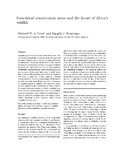| dc.contributor.author | Fynn, R.W.S. | |
| dc.contributor.author | Bonyongo, M.C. | |
| dc.date.accessioned | 2011-04-12T13:47:21Z | |
| dc.date.available | 2011-04-12T13:47:21Z | |
| dc.date.issued | 2010-11 | |
| dc.identifier.citation | Fynn, R.W.S. & Bonyongo, M.C. (2010) Functional conservation areas and the future of Africa's wildlife, African Journal of Ecology, November, pp. 1-14 | en_US |
| dc.identifier.uri | http://hdl.handle.net/10311/781 | |
| dc.description.abstract | Ungulate populations in African conservation areas (CAs) are in widespread decline, which can largely be attributed to a lack of functionality of the area encompassed by the CAs themselves. We present evidence from a wide range of African CAs showing that they do not encompass both the functional wet- and dry-season resources that ungulates traditionally migrated between. Before human populations and economic development had grown to levels where they interfered with migrations outside the CAs, ungulates were able to make use of their traditional seasonal resources but this is becoming increasingly difficult and we are now seeing the effects of this restriction of movement on ungulate population numbers. New innovative strategies are required for the conservation of African wildlife. An urgent Africa-wide survey is needed to establish past and present functional resources in and around CAs and to prioritize conservation regions that are most functional. In addition, innovative attempts need to be made to reconsolidate functional seasonal resources within revised expanded protected areas. | en_US |
| dc.language.iso | en | en_US |
| dc.publisher | Wiley | en_US |
| dc.subject | Ecological gradient | en_US |
| dc.subject | Habitat fragmentation | en_US |
| dc.subject | Kruger National Park | en_US |
| dc.subject | Kgalakgadi | en_US |
| dc.title | Functional conservation areas and the future of Africa's wildlife | en_US |
| dc.type | Published Article | en_US |
| dc.link | http://onlinelibrary.wiley.com/doi/10.1111/j.1365-2028.2010.01245.x/pdf | en_US |

